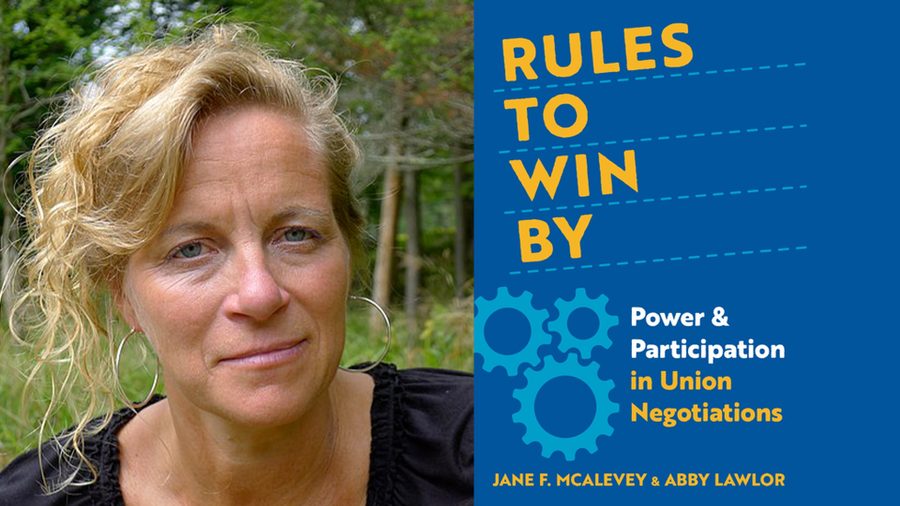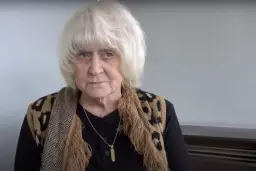Winning Is Only the Start: Jane McAlevey on Building Worker Power
Veteran organizer Jane McAlevey on the long-game of building union power through contract negotiations.
Paige Oamek

In April 2022, Amazon workers in Staten Island voted to form a union. But a year after that historic victory, union members at the JFK8 warehouse still don’t have a contract, thanks largely to Amazon spending $14 million on union avoidance consultants. That may be shocking but it’s not unusual. When workers vote to form a union, it takes an average of 465 additional days to sign a contract with their employer. Meanwhile this spring in Buffalo, where the first Starbucks Workers United election was won in 2021, a new decertification petition attempted to extinguish the spark that inspired hundreds of other locations to follow suit. As these hotly contested victories show, winning a union election is only the first step, and bosses fight tooth and nail to avoid the bargaining table, whether through efforts to decertify new unions or other legal objections.
In her fourth book on union organizing and building the power of the labor movement, Jane McAlevey, veteran organizer and Senior Policy Fellow of the UC Berkeley Labor Center, continues to provide working people with the tools needed to build and strengthen workplace democracy, this time with a focus on winning successful contracts. Rules to Win By: Power and Participation in Union Negotiations, co-authored with researcher Abby Lawlor, presents six recent compelling case studies, including Boston hotel workers, New Jersey teachers and Philadelphia nurses. McAlevey, who trained two of the workplaces in organizing, power structure analysis and negotiations, recounts how and why the unions involved succeeded.
As her first book since President Joe Biden’s election and the COVID-19 pandemic, not to mention the high-profile union elections at Amazon and Starbucks, Rules to Win By “extends the theory and logic of high-participation organizing into high-participation negotiations.” In Rules to Win By, Lawlor and McAlevey provide a playbook for successful negotiations, paving the way for the next chapter of a blossoming labor movement. McAlevey spoke with In These Times this May.
Paige Oamek: You write that how workers negotiate their contracts is fundamental to what kind of union they become, but that bosses’ legal strategies can often stifle that first strong contract. What kind of union busting can occur post-union victory?
Jane McAlevey: In the United States, few people understand that the employer gets two complete attempts to destroy a workers’ organization. The first is the terror campaign that goes on during the unionization effort. But unless and until workers go on to negotiate a first contract, functionally speaking, there isn’t a union in place.
There’s nothing straightforward about how this works. For example, at Starbucks, the union election was certified by the NLRB (National Labor Relations Board), which was great, but with certification, a time clock starts on securing that first contract. Under the National Labor Relations Act, once a union is certified, they have 12 months to reach an agreement or management can begin to decertify the worker’s union. Officially, workers have to file the paperwork for decertification, but in practice and in my experience, these are management-directed actions. Unfortunately, that’s what we just saw in Buffalo. It’s classic union-busting.
I want to contrast that with the Amazon JFK8 election, where Amazon has been filing legal election objections to the NLRB since the workers won. So there isn’t that same 12-month clock ticking, but there is a second route to break the union post election. There’s been no contract talks at all at JFK8 because the employer is taking what I call the “Smithfield Foods approach” of appealing the actual election, with Amazon asserting typical lies to invalidate what was clearly a legitimate election. In my book No Shortcuts, I talked about the near 16-year legal appeal strategy that Smithfield Foods infamously used to delay ever getting into contract negotiations.
The truth is, in order for a union to stand any chance of getting to their first contract negotiations, the organizing work has to continue. It has to be incredibly strong, high-participation and public for workers to stand a chance of overcoming the union-busting that will continue. You cannot stop organizing when you win the election. You must keep building power, achieve supermajority unity and, once the workplace shop is strong, you’re probably going to have to bring the public into the campaign.
PO: How can workers fight back against these tactics?
JM: People must be clear, transparent and direct with workers upfront that their employer is going to have two bites at the apple. So they also need a two-pronged struggle: first to win the election and then to force them to the negotiation table. The clearer that is upfront, the better the chances are that the workers will understand what’s required to actually get a contract.
One example is putting out something like a majority petition, which is a structure test. If you’ve won the election, you must keep people focused on the fact that their active participation is what’s going to potentially lead to a good contract. That petition says the majority voted to form a union and now we demand that the employer start negotiating a fair contract.
We know the union busters are going to lie. They’re gonna say, “The workers here don’t really want a union.” That is Amazon’s message over and over, despite the fact that workers at JFK8 voted overwhelmingly for a union.
The petition process is also a great time to do a contract survey: “Hey, we just voted to form a union, let’s figure out what we want from it.” A good contract survey is always done face-to-face and it’s an organizing process to start raising people’s expectations. Sadly, the overwhelming approach of trade unions in the United States is to do anonymous surveys online. If you don’t feel comfortable saying to somebody in a conversation, “What is it you want to win in the contract?” it’s not likely that the worker will participate in the contract campaign. Every single structure test before and after an election is helping build relationships and trust worker-to-worker. By setting a majority goal for the contract survey process and conducting it through one-on-one conversations among coworkers, you’re communicating that these demands aren’t going to be won unless each person is actively involved in building the power to win.
PO: You explicitly lay out the goal of having every worker show up to negotiations at least once. Why?
JM: You’ll often hear unions say: ‘The U in union is you.” But how a worker comes to see themselves as central to their own organization is a different story. It’s one thing to talk about it, it’s another to have them experience it. I have never seen a more transformational experience than when a worker actually sees their employer fighting them tooth and nail on basic demands. Particularly for workers who are skeptical about being part of a union, nothing transforms their understanding quite like that experience. For the first time, they’ll see through all the union busters’ rhetoric and see that we are actually a group of workers going up against our employer.
It doesn’t mean every worker comes for the whole bargaining session. It may be about getting them there for 30 minutes. The goal is getting everyone in that room at least once and making it easy for workers to participate.
PO: This is your first book since COVID, as well as the recent labor upsurge. Do you think we’re in a fundamentally different place in the labor movement today?
JM: Yes and no. In 2018, we saw the largest number of strikes, and of workers on strike, than we had seen in 30 years. Before the pandemic, there was already a lot happening in terms of workers taking action, including in right-to-work states and illegal strikes. It’s important to note there was already a turn happening with workers deciding to stand up and fight for themselves.
The pandemic consolidated that motion. Workers were told, “you’re essential,” while CEOs and executives were sitting at home. Then, as millions of workers seek some justice for the sacrifices made during the pandemic, they get union busting, no raises or crappy raises, and no recognition or respect. That has expanded and consolidated the anger.
There’s a lot of exciting energy happening right now and we’re seeing it through lots of different strikes and unionization efforts. How long it lasts, in some ways, is up to the organizers and the decision makers in national unions: Do they enable workers to win, or do they continue their decades-long lowering of workers’ expectations?
PO: Among the flurry of new unions being created, we’re also in the midst of a union reform movement, with the UAW, the Teamsters, the UFCW, etc.
JM: The changes in the UAW and Teamster leadership are very important and hold the potential for real change in those unions. But I think there are options for union reform in every contract negotiation in every union. For example, the focus of Rules to Win By is to show what union democracy looks like. The driving reason for most workers is not some idealistic image that unions make the world better. Instead, they form or join a union to achieve a good contract that’s going to win them some material gains and dignity on the job.
Therefore, the simplest, best way to deal with the question of reform is actually to do it: by opening up the negotiations process, making it transparent, electing really big worker committees and then facilitating workers’ capacity to participate.
PO: A lot of workers are pushing back against tiered contract systems that were implemented in previous contracts, in which new hires lose out on the existing benefits won. How does union democracy help fight those tier-system workplaces?
JM: If workers are in the room and invited to participate in large numbers, it’s not likely that they’re going to agree to a multi-tiered contract. Which is precisely why most unions resist having workers in the room. If you’re doing traditional, top-down, secret negotiations behind closed doors — meaning people agree to gag orders — workers have no idea what’s going on in their own negotiations until it’s time to ratify. It’s just, “Hey, do you want these raises?” along with screwing the workers coming behind you.
Most negotiators and most established unions are nervous about direct accountability from workers. If they’re concerned about their next internal election, the union will promise existing workers they get to keep what they have, but they’re going to sacrifice the people that come behind them. It seems like a simple solution but it destroys the entire union in the end. That’s what tiered agreements do — they destroy solidarity and they destroy the organization. If workers are in the room, they’re not likely to agree to such a thing.
PO: What other contract stipulations limit solidarity?
JM: 99% of contracts in the United States have “no strike, no lockout” language, which guarantees that workers won’t be locked out during the life of the contract and that workers shall not strike until such time as the contract expires. This is one good reason to negotiate short-duration contracts, as I talk about in the book.
In October 2022, the Amalgamated Transit Workers Union made a really bold decision to endorse and fully embrace transparent and open negotiations and short contracts. They recognize that conditions change a lot, so why would you want to be locked into a four-, five- or six-year contract? What are you going to do if the cost of living or inflation goes crazy? One strategy is you have short contracts. I actually think that’s really smart. If you’re going to create a fighting union, then this is a terrific way, every two or three years, to keep rebuilding the union’s muscle.
No strike-no lockout language expires when union contracts expire, and that’s when workers can strike. But what can also happen is the employer has the right to cut off union dues literally the day the contract expires. In Massachusetts, a nurses’ union went through that experience when they issued a strike threat. The nurses leading that struggle decided that day that they were never going to risk having an employer be able to shut off their money again. Over a five-year period, they moved every single chapter from an employer-deduction method of dues collection (the most common among all unions), to a direct dues payment system, completely bypassing the employer.
PO: In the book’s conclusion, you move to consider negotiations on a larger scale: using the idea of high participation to build governing power.
JM: It’s unfortunate there’s such a lack of experience with negotiations outside of the trade union movement. It’s a reflection of the lack of power we have as social movements right now. You have to build enough power to create a real crisis for an employer, to get corporate bosses or other decision-makers into the room to even have negotiations. These principles laid out in the book apply across the board, be it for tenant unions, community groups or legislative negotiations. The more people involved, the more people understand the stakes of the fight, and the more people understand what the opposition is, the better your side is set up to win.
This also translates into the electoral system in the United States. Part of what we know is that political education is a really fundamental responsibility of both unions and non-union formations in this country. There is no better political education than inviting people into the process of an organization’s small-n negotiation. All the employer’s or elites’ lies are out in the open in the negotiations process.
But we need way more power being built. We need people out of advocacy mode, out of mobilizing mode and into really serious organizing, so that more organizations of all kinds are actually in the position to have these kinds of negotiations. In both a union or non-union setting, the same principles apply. Transparent, big and open negotiations are fundamentally an asset to the political education process, which we need a whole lot more of in this country right now.
Paige Oamek is a writer and fact-checker based in New York. Their writing appears in The Nation, The American Prospect and elsewhere.








